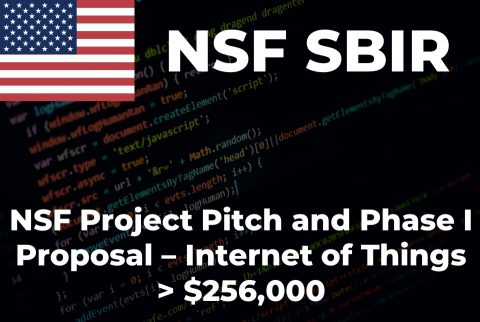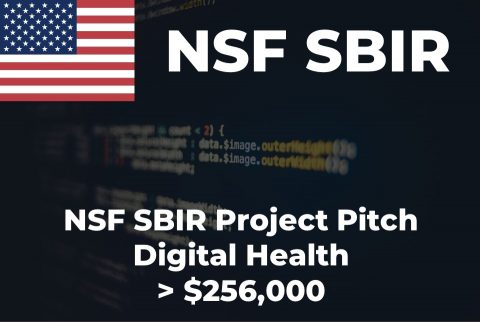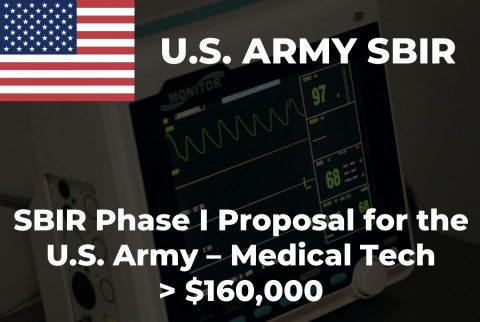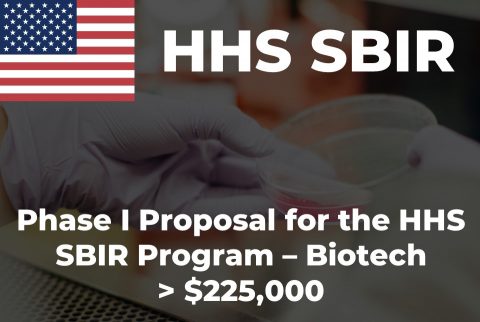Nail your NSF Project Pitch
Follow our free guide to write a winning NSF project pitch and
be invited to the NSF SBIR STTR program Phase I application.
About this NSF Project Pitch Guide
Since 2019, the National Science Foundation requires a Project Pitch as the first step in the SBIR STTR Program application. The 1500-words pitch allows entrepreneurs to know within three weeks if the innovation idea it's suitable for the program. After reviewing the project pitch, the NSF will:
- Invite the business to submit a full SBIR STTR Phase I proposal within the next 12 months, or
- Provide feedback on why the idea is not a good fit for the program and how to improve it for resubmission.
After having helped dozens of technology companies write winning R&D project pitches for the NSF and other programs, we realized that for those entrepreneurs that are good at writing technical content and have time, the best option is to write the pitch themselves. We published this free guide so that innovators can adapt it and write their winning NSF Project Pitch.
Because the NSF SBIR STTR Program covers more than 30 technology topic areas, and every idea and R&D project has its differences, this guide gives an overall approach and generic tips that you should adapt to your case, so don't take it rigidly.
This guide is for you if:
-
You are good at technical writing
-
You know how to present complex concepts impactfully
-
You have time and want to do it yourself
Otherwise, check out how we can help you:
0 / Define how your idea meets the criteria
Before starting with the project pitch writing, make sure you understand the NSF SBIR STTR Program objectives and award criteria, and define how your innovation idea meets these and how you can explain it.
When determining which projects to fund, the NSF looks for technology innovations that can change people's lives or revolutionize an industry, require research and development funding because of the technical risks involved, have evidence of market fit, and have the potential to scale a business and make a large impact.
So, before you start writing the project pitch, answer these questions:
- Has the innovation the potential to improve people's lives or change and industry?
- Does the innovation require research and development funding because of the level of technical risks involved?
- Is there evidence that the idea could meet unserved market needs?
- If successfully developed, could the innovation become the foundation of a scalable business?
And determine which of the following NSF R&D definitions better describes your idea:
- A systematic, intensive study directed toward greater knowledge or understanding of the subject studied;
- A systematic study directed specifically toward applying new knowledge to meet a recognized need; or
- A systematic application of knowledge toward the production of useful materials, devices, and systems or methods, including design, development, and improvement of prototypes and new processes to meet specific requirements.
It is important that, before kicking off the NSF Project Pitch writing, you make sure you are ready to show that your project idea is not straightforward engineering but genuine Research & Development involving a certain level of technical risks that prevent it from raising funds from other sources like loans or venture capital.
1 / The Technology Innovation
The NSF defines this 500-words max section as follows:
Description of the technical innovation that would be the focus of a Phase I project, including a brief discussion of the origins of the innovation as well as an explanation as to why it meets the program’s mandate to focus on supporting research and development (R&D) of unproven, high-impact innovations.
Adapt the following outline to your case but keep the background - problem - solution pitch structure. Make sure you keep it concise and straight to the point.
- Start with one paragraph introducing the background to where your innovation applies and a description of what is lacking, for example, current problems, gaps, needs, etc. Link this to the idea that your innovation could solve the highlighted needs by providing what is missing, solving some problems, closing some gaps, etc.
What you present in this paragraph will depend entirely on your idea, but some examples are: describing the proliferation of similar systems or methods that only solve the problem partially, lack of bridge technologies to unlock the potential of the existing systems, knowledge gaps or lack of techniques that prevent science from exploring out-of-bounds fields, etc. - Continue with one or two paragraphs developing the pain points introduced above, and provide examples of how the current technology/sate-of-the-art cannot solve these because of its inherent limitations.
- Introduce what is preventing society (markets, industries, research institutions, etc.) from producing new technologies or gaining new knowledge that could solve the above pain points and link it to a generic description of your innovation.
- Pitch your innovation in a couple of sentences in a way that directly responds to the needs/gaps/problems introduced above. Think about this as what you would tell an investor if you only had 15 seconds.
- Close the section with an explanation of why, at its core, the innovation solution involves Research and Development work (remember the R&D definition you chose before), and list the R&D activities that the project will involve at a very high level (as an introduction to the next section, not intended to be developed here).
2 / The Technical Objectives and Challenges
The NSF defines this 500-words max section as follows:
Description of the R&D or technical work to be done in a Phase I project, including a discussion of how and why the proposed work will help prove that the product or service is technically feasible and/or significantly reduce technical risk. Discuss how, ultimately, this work could contribute to making the new product, service, or process commercially viable and impactful. This section should also convey that the proposed work meets the definition of R&D, rather than straightforward engineering or incremental product development tasks.
Adapt the following outline to your case but keep the project & risk plan like structure.
- Kick-off this section with an overview of what a successful Phase I project outcome would be. What would the achieved scope be? What would you consider a total success? Use technical terms and avoid limiting this to generic descriptions. For example, if you consider a complete success the development of a prototype able to accomplish a specific task, name it. Keep in mind that NSF SBIR STTR Phase I projects are funded up to $256k and have a duration of 6 to 12 months. Be ambitious but not unrealistic.
- Present why, by providing the successful outcome introduced above, the Phase I project will demonstrate that the innovation can solve the pain points introduced in The Technology Innovation section. It is key that you keep the pitch's parts linked, so it makes sense as a whole.
- Describe the technical work involved in achieving the Phase I project outcome, in the form of a very high-level project plan. Get technical and list the tasks that you will need to complete in the R&D project. The reviewers will value positively that you have a clear technical vision of what needs to be done to succeed in the Phase I project.
- Expand on the challenges that accomplishing the above tasks will have and link these to the most relevant project technical risks. Make clear that the project involves exploring new areas, and so there are risks that can't be totally avoided. If there are no risks, the project is not R&D. By presenting the project risks in a technically profound way, you'll show confidence and know-how.
- Once the point about the risky endeavor is clear, explain how the proposed project fits in the R&D definition you have chosen (see section 0 above) and describe how the work described aligns with the NSF SBIR STTR Program objectives.
3 / The Market Opportunity
The NSF defines this 250-words max section as follows:
Description of the customer profile and pain point(s) that will be the near-term commercial focus related to this technical project.
Follow this outline and adapt it to your innovation:
- Begin with a concise definition of the innovation paying end-users, highlighting the most relevant needs the innovation would solve for them.
- Include a list of examples of these customers (categories, not proper nouns) and describe their typical problems that your innovation could solve. For example, biotech companies having to comply with strict health data privacy standards would benefit from an AI-powered compliance solution like the one proposed.
- It is critical to show that you understand the market and end-user problems so that this knowledge can become the base for a successful, high-impact business. If you have reliable figures to support the examples, include them to show awareness.
4 / The Company Team
The NSF defines this 250-words max section as follows:
Description of the background and current status of the submitting small business, including team members related to the technical and/or commercial efforts discussed in this Project Pitch.
This section is the most straightforward one, simply ensure relevance:
- Include one paragraph with the company description keeping it relevant to the innovation topic and market. If it is a new company with no history to share, use founders' background to show expertise.
- List the team members and include brief but highly relevant bios. Remember that you need to show both technical know-how to succeed in R&D and market knowledge to make the innovation an impactful and scalable business.
- There is no by default team structure, but it should include at least two people: the Principal Investigator (technical project lead) and Commercial Lead (the one with the market vision). For start-ups, these are usually the founders (CTO and CEO, for example). If you think that the technical expertise or market knowledge is best shown by including more key personnel (matter advisors), feel free to do so.
5 / Submitting the NSF Project Pitch
Submitting the NSF project pitch is really simple:
- Create an account here: https://nsfiip.force.com/sbir/s/login/SelfRegister
- Fill in your company data and answer the formal questions about your participation in the SBIR STTR program
- Copy the project pitch sections in the form. We don't recommend writing in the online form, it's better to write it in your preferred word processor and then copy/paste the sections. Ensure that each section is under its word limit (500, 500, 250, and 250 words respectively)
- Submit it!
Need help?
This NSF Project Pitch guide is intended to help you write it by yourself for free. However, we recommend this approach only if you are good at technical writing, know how to present complex concepts impactfully, and have time to invest.
Otherwise, we offer two services to suit your needs. Check them out!
Highlighted Cases in R&D
Hey!
It's me, Javi, the BizCusp Lead Consultant
Just two quick notes:
#1 If AI in proposals is something that interests you, I go deep dive with particular use cases here: DeepRFP/blog, such as, for example, executive summaries, compliance matrices, outlines, color teams, assessments, and more. It is also where you can try 15+ AI bidding tools for free.
#2 I talk proposals twice a week with 2000+ professionals here: jescartin.com. Of course, we discuss tech & AI, but also a bunch of bidding tips, career insights, stories, ideas, and other good stuff. Join us!






